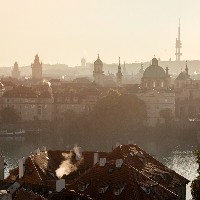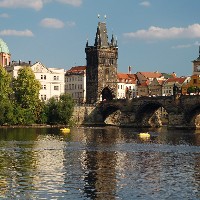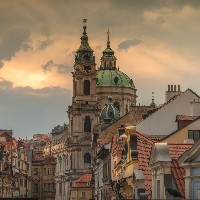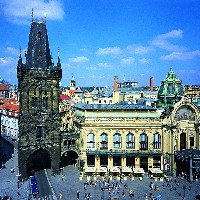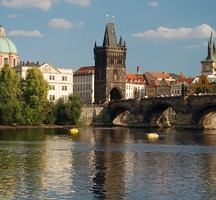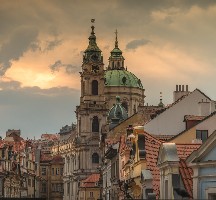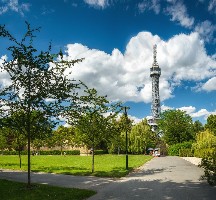Breadcrumbs navigation
The Towers of Prague
The descriptive names of “Golden Prague” and “City of a Hundred Spires” provide a hint of the nature of this metropolis, where the eyes of visitors and tourists alike are drawn upwards to the towers of the city’s many cathedrals, churches, and gateways.
However, there is another way to experience Prague’s unique beauty and the soul of the city – to look down from these towers and admire the unusual bird’s-eye view of the historical squares, red tiled roofs, and the Vltava River with its many bridges and long waterfront.
The towers, which were not a part of the individual churches and thus owned by the church were, for the most part, the property of the town or municipality. They were a part of the fortifications and used as guard towers that were locked for the night. Quite often they were used by the town criers to make announcements. For example, trumpets and signals visible at a great distance were used to notify citizens of a fire and its location as conflagrations were very common in towns in the past. Many towers were equipped with bells ringing out the time of day, some served as a customs house at the entrance to the town, and yet others were used for storage.
It is possible to count the total number of towers in Prague only from a great height. Recently a few enthusiastic experts and Prague aficionados tried to do exactly this – from an aerial view they counted 120 important towers just in the central part of the city, which they also photographed, documented in detail and measured. The total number of towers in all of Prague, not counting the turrets found on some burgher houses and villas, has been estimated at about a thousand. The most valuable and beautiful towers have been made accessible to the public. Choose from our list or, better still, extend your stay in Prague and explore them all, as each offers a different – but always unforgettable – view of the most impressive parts of the city.
The Old Town Bridge Tower is the gateway to the famous Charles Bridge from the east side of the Vltava. Completed before 1380 as part of the fortifications of the Charles Bridge, it is considered to be the most beautiful Gothic gate in Europe and the most impressive example of Gothic civil engineering style in the world. It is the work of the court artisan Peter Parler, who was also the architect for the Charles Bridge. This gem of Gothic architecture took almost a quarter of a century to build and required the labour of one hundred stonemasons. In 1621 the heads of some of the Czech lords convicted and executed for their involvement in the uprising against Habsburg rule were displayed at this location to serve as a warning to others. Then, in 1648, the tower was damaged during the Swedish siege of Prague. The façade of the Old Town Bridge Tower is decorated with rare Gothic figural and architectural elements. At the level of the first floor you can admire a statue of the standing St. Vitus, who is the patron of the bridge, flanked by statues of the seated Charles IV and Wenceslas IV. One level higher you will find statues of St Adalbert and St Sigismund. All of these sculptures are outstanding examples of late 14th century stonework. The area above the gateway leading from Old Town is adorned with the emblems of the countries over which Charles IV ruled. A spiral staircase with 136 stairs leads from the gateway entrance up to the tower. The view from the tower, taking in the Castle District, the famous gallery of statues lining the Charles Bridge and the adjacent part of Old Town, is unforgettable.
There are actually two Lesser Town Bridge Towers, which stand on the opposite side of the river. Although the view from this location is entirely different, it is just as impressive. The taller tower was built after 1464 on the site of an earlier Romanesque structure and its design is based on the architecture of the Old Town Bridge Tower, however the originally planned sculpture decorations were never added. An older smaller tower of Romanesque origin and dating to about 1170 is separated from the main tower by a fortified gateway.
The tower located next to the well-known Church of St Nicholas with its large green copper dome offers yet another view of the picturesque red roofs of the magical Lesser Town. The structure, which served as both a bell tower as well as a town crier’s tower, was built in 1755 by the famous architect Kilian Ignaz Dientzenhofer, who also prepared the designs for the church. However, the tower belonged to the Lesser Town municipality and not to the church, as is evidenced by the Lesser Town emblem installed above the entrance. It was the last town crier’s tower built in Prague and was also used to raise an alarm amongst the population in case of fire. During the communist regime the tower was used as an observation post by the state secret police. In the 1990s, the tower was restored and the interior was modified to allow public access. There are 299 steps leading up to the observation deck which is located at a height of 65 metres.
A different incomparable view can be seen from the tower of the Old Town Hall, which was originally the seat of the Old Town administration. The core of the complex consists of the oldest building built in Gothic style and with a richly decorated portal. A massive square tower with a height of 66 metres was added during the 14th century. The astronomical clock “Orloj” was installed in it at a later date and it is one of Prague’s most famous towers. On the first floor of the tower there is a chapel with a richly ornamented bay window that looks into the chamber housing the twelve colourful carved figures of the apostles, who appear every hour in the two windows. The movement of the apostles also activates the figures along the sides of the clock – a skeleton representing Death, a Turk representing the Infidel, the Miser, a figure representing Vanity and a rooster. At the bottom of the clock there is a calendar board with the signs of the zodiac which is the work of the famous painter Josef Manes. On the corner of the bay window there is a copy of the remarkable Gothic statue from the late 14th century, which is known as the Old Town Madonna.
On the last day of World War II – the 8th of May 1945 – the Town Hall was shelled and caught fire. The eastern wing was destroyed and the tower was heavily damaged. Surprisingly, the unique lift in the Town Hall tower, dating to 1927, was saved. Today it is stored in the National Technical Museum and the tower gallery is reached by a new lift with barrier-free access that was installed in 2000. The tower offers a beautiful view of Prague’s oldest and most important square – the Old Town Square – with its famous Jan Hus monument and ringed by a number of landmark buildings. The dominant structure, located directly opposite the tower, is the Church of Our Lady before Týn. Other important buildings include the Baroque Church of St Nicholas, the Rococo Goltz-Kinsky Palace, and one of the city’s most valuable buildings – the Gothic urban palace known as the House at the Stone Bell.
Additional interesting views of the city are offered by the Late Gothic Powder Gate Tower, which was completed in 1475. It was built as a part of the town’s fortifications and, at the same time, served as the monumental entrance to Old Town. This gateway was used by the coronation processions of Czech kings. It is adorned with statuary which, for the most part, was sculpted by Matěj Rejsek, the famous architect who designed the entire gateway. In the 19th century, it was rebuilt in Late Gothic style. The structure is 65 metres high; the viewing gallery is at a height of 44 metres and is reached by a spiral staircase with 186 steps. The name Powder Gate Tower dates to the 18th century, when the structure was used as a gunpowder store.
Rising up above the buildings of the Clementinum complex, which houses the National Library, you will find the 68-metre tall Astronomical Tower. The top can be reached by climbing the 172 steps of a steep spiral staircase. A gigantic lead statue of Atlas holding a globe is installed on the domed roof. The history of the tower is closely linked to university education dating back to the time when mathematics and astronomy played an important role. From about 1750 astronomical and climatic observations and measurements were taken from here and the tower was fitted with astronomical instruments. In 1775 Antonín Strnad started to keep systematic records of meteorological and climatic measurements and they are still maintained today. From 1842, the coming of midday has been announced by the waving of a banner from the Clementinum. Between 1891 and 1926, this was accompanied by a volley of cannon shots from Prague Castle.
The six-storey Novomlýnská Water Tower, which was made accessible to the public only recently, has a rather unassuming appearance. The original structure, dating back to the mid-17th century, was located right on the Vltava River and supplied water to public fountains in the surrounding areas of the New Town. On the highest floor, directly above the water tank into which water from the Vltava was pumped, an extensive observation space was built with 12 large windows, called the “Lusthaus”, where the city administrators would hold social gatherings. It is considered the first observation tower in Prague (despite its inaccessibility). Due to the buildings that now surround it, its view of the city is limited, but it’s still worth a visit. Here you’ll find a unique interactive exhibition on fires in Prague and the history of the Prague fire department.
The youngest, and also the tallest tower, in Prague’s centre is the 58,7-metre high Petřín Lookout Tower that stands on the top of Petřin Hill at an altitude of 327 metres. From the top the entire city is laid out before you. It was built in 1891 as a loose copy inspired by the Eiffel Tower in Paris. The observation tower is an octagonal steel structure with a lift shaft in the middle and a double spiral staircase with 299 steps. The lower wider walkway has barrier-free access. The lift then continues all the way up to the narrow walkway that is 60 metres above the ground. The top of Petřín Hill can be reached by the funicular that is boarded at the foot of the hill at the Újezd stop. Even at night the illuminated main body of the tower is visible from afar.
Prague City Tourism
